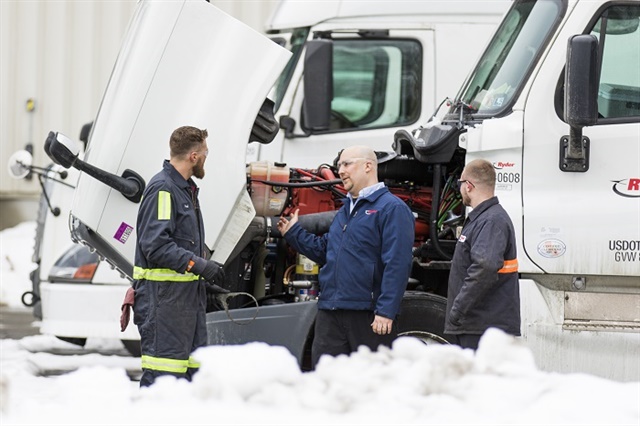A key way that fleets can ensure that trucks are prepared for winter and drivers are able to get help if they need it, is to have a comprehensive maintenance partner. Photo: Ryder System
When Winter Storm Grayson blew through the Northeast, bringing snow, winds and freezing temperatures HDT spoke with Ryder System Vice President of Maintenance Operations and Engineering Bill Dawson about how to deal with bad winter weather.
While most of the impact from a winter storm will directly affect drivers, Dawson said that drivers are professionals, and many of the disruptions caused by a storm can be traced back to fleet preparedness.
“The last thing drivers want is to have an interruption because they’re the ones stuck by the side of the road — they’re a participant, not the root cause of disruptions,” said Dawson. “The most common mistakes are made by not taking preventive measures that you need to take before winter arrives.”
All fleets should remember to prepare trucks for driving in difficult conditions by keeping trucks up to date on regularly scheduled maintenance and by keeping them prepped for cold conditions, such as by providing fuel that is treated and blended for low temperatures, said Dawson.
For instance, Winter Strom Grayson could bring temperatures as low as -40 degrees to parts of the U.S. and below zero temperatures up and down the entire East Coast. Diesel exhaust fluid can freeze at temperatures below 10 degrees Fahrenheit, even while a vehicle is idling, and low fuel tanks can trap condensation, which is prone to freezing, Dawson told HDT.
Fleets should have a well-thought-out process for keeping trucks that are not in operation from freezing during extremely cold temperatures so they are ready to go when needed.
Fleets also need to regularly keep drivers up to speed on training for winter driving, starting as early as September to discuss these topics with drivers. All drivers, including new drivers and drivers who are based in warmer climates that might be passing through winter weather, should have regular refreshers.
But beyond all fleet preparedness tactics, drivers are the ones who will be faced with dangerous conditions from snow, cold, and high winds. And the most important thing a fleet can do is allow the driver to make the right decision for the situation.
“Make sure they understand that they’re the captain of the ship, that they are able to make the decision and are supported by the management of the organization,” said Dawson. “If they don’t feel that the operation is safe, then they don’t need to complete that operation.”
“That’s not an easy thing to put in place because you run the risk of disrupting your supply chain, upsetting a customer – any number of things. But the truth is, anything less than that level of responsibility down at the driver level is asking for trouble.”
For drivers, there are obvious steps they can take to stay safer in winter:
- Wear a seat belt
- Watch the dashboard lights for maintenance problems
- Be mindful of current conditions
- Give 20 or more feet of additional space for safe stopping distance
- Avoid hitting the brakes suddenly
- Be careful about trucks idling at extremely low temperatures
- Get snow and ice off of the roof for the safety of other motorists
- Have a checklist to stay prepared for the worst
- Have an emergency supply of water, blankets, clothes, and non-perishables in case they get stranded

Photo: Ryder System
It is also important for drivers to perform a high-quality pre-trip inspection to make sure a vehicle is ready to go. The idea is to avoid any maintenance problems if possible, especially those that might have been spotted beforehand. But despite all of the preparation, should a driver become stranded, getting help is the most important thing they can do to prevent disaster.
“Get in immediate contact with somebody that can help. Having someone you can reach out to immediately is extremely important,” said Dawson. “If you don’t think you’re going to have help provided quickly, call 911.
“Do not be a hero; do not leave yourself in harm’s way,” he added. “Somebody needs to come get you if you’re stuck because it’s not going to get better by itself.”
A key way that fleets can ensure that trucks are prepared for winter and drivers are able to get help if they need it, is to have a comprehensive maintenance partner, either in-house or outsourced, Dawson suggested.
“Be smart. Start thinking about this in the autumn season and have a plan and make sure somebody or multiple people in your organization are directly responsible for executing that plan.”
A good source of information on winter weather is Ryder System’s winter preparedness website, which offers tips for fleets and drivers on vehicle maintenance and preparation and explains what Ryder does for fleets that partner with it for maintenance services.
CUT COTS OF THE FLEET WITH OUR AUDIT PROGRAM
The audit is a key tool to know the overall status and provide the analysis, the assessment, the advice, the suggestions and the actions to take in order to cut costs and increase the efficiency and efficacy of the fleet. We propose the following fleet management audit.




